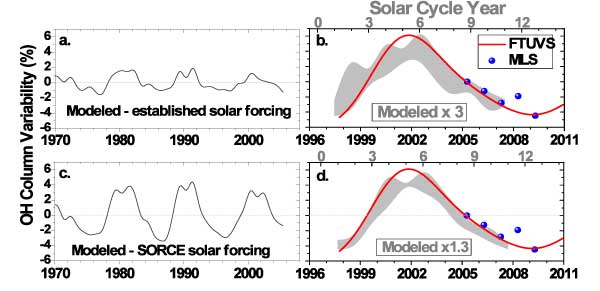Observed solar UV changes during 2004 - 2007 from the SORCE satellite are much larger than predicted by established models.
OH data from the Microwave Limb Sounder (MLS) on Aura (~5 yr) and a ground-based FTUVS (~13 yr) suggest a response of the OH column to the solar cycle that is significantly larger than model results using established solar forcing. Model runs using a solar forcing based on SORCE UV data agree better with MLS OH observations.
It is essential to have the proper solar forcing in photochemical models and climate models to understand variability in middle atmospheric hydrogen chemistry that affects ozone and natural influences on climate.

The modeled OH change using established solar forcing (top left) is too small. A factor of ~3 is needed to match the OH change extracted from FTUVS and MLS data (top right). The model using SORCE solar forcing (bottom left) agrees much better with observations (bottom right)
References [Wang et al., submitted to PNAS, 2011] Cageao RP, et al. (2001) High-resolution Fourier-transform ultraviolet-visible spectrometer for the measurement of atmospheric trace species: application to OH. Appl Opt 40(12):2024-2030. Wang S, et al. (2008) Validation of Aura MLS OH measurements with FTUVS total OH column measurements at Table Mountain California. J Geophys Res 113:D22301 10.1029/2008JD009883. Snow M, McClintock WE, Rottman G, Woods TN (2005) Solar-stellar irradiance comparison experiment II (SOLSTICE II): examination of the solar-stellar comparison technique. Sol Phys 230:295-324. Harder JW, et al. (2010) The SORCE SIM solar spectrum. Comparison with recent observations. Sol Phys 263:3-24. Haigh JD, Winning AR, Toumi R, Harder JW (2010) An influence of solar spectral variations on radiative forcing of climate. Nature 467:696-699.
11.23.2011